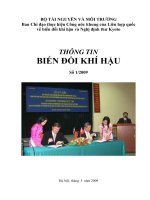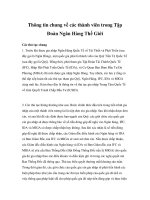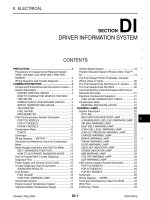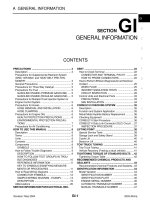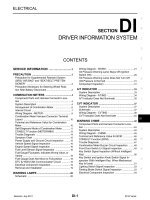toyota rav4 1994-2000 foreword - thông tin chung về xe toyota rav4 đời 1994-2000
Bạn đang xem bản rút gọn của tài liệu. Xem và tải ngay bản đầy đủ của tài liệu tại đây (8.36 MB, 71 trang )
Manual Name
Pub. No.
S 3S−FE Engine Repair Manual
S TOYOTA RAV4 Chassis and Body Repair
Manual
S TOYOTA RAV4 Chassis and Body Repair
Manual Supplement
S TOYOTA RAV4 Electrical Wiring
Diagram
S TOYOTA RAV4 Electrical Wiring
Diagram Supplement
S TOYOTA RAV4 New Car Features
S TOYOTA RAV4 Repair Manual
For Collision Damage
S Fundamental Painting Procedures
S Fundamental Body Repair Procedures
BRM024E
BRM002E
NCF108E
BRM045E
EWD234F
EWD206Y
RM454E
RM395E
FOREWORD
This repair manual has been prepared to provide essential
information on body panel repair methods (including cutting
and welding operations, but excluding painting) for the
TOYOTA RAV4 5−DOOR.
Applicable models: SXA11 series
This manual consists of body repair methods, exploded dia-
grams and illustrations of the body components and other
information relating to body panel replacement such as han-
dling precautions, etc. However, it should be noted that the
front fenders of the TOYOTA model is bolted on and require
no welding.
When repairing, don’t cut and join areas that are not shown in
this manual. Only work on the specified contents to maintain
body strength.
Body construction will sometimes differ depending on specifi-
cations and country of destination. Therefore, please keep in
mind that the information contained herein is based on ve-
hicles for general destinations.
For the repair procedures and specifications other than colli-
sion−damaged body components of the TOYOTA RAV 4
5−DOOR refer to the following repair manuals.
If you require the above manuals, please contact your TO-
YOTA Dealer.
All information contained in this manual is the most up−to−
date at the time of publication. However, specifications and
procedures are subject to change without prior notice.
TOYOTA MOTOR CORPORATION
RM401E
mm in.
150
250
5.91
9.84
QUARTER PANEL (CUT)
QUARTER PANEL
RH:
LH:
1. Cut and join the parts at the location shown above.
HOW TO USE THIS MANUAL
Each repair method description provided in Section RE of this manual comprises two pages, divided into 2
blocks (REMOVAL AND INSTALLATION) and includes illustrations to facilitate body repair.
RE−10
BODY PANEL REPLACEMENT
REMOVAL
[Cut and Join Location]
250 mm
Cut and Join Location
Cut and Join Location
(Cut Location for
Supply Parts)
Cut and Join Location
(Cut and Join Location )
Braze
REPLACEMENT PARTS AND METHOD
(CUT)
Replacement method
(ASSY) Assembly replacement. . . . .
(CUT) Major cutting (less than 1/2 of parts used). . . . . .
(CUT−H) Half cutting (about 1/2 of parts used). . . .
(CUT−P) Partial cutting (most of parts used). . . .
Replacement Parts
PARTS LOCATION
REMOVAL DIAGRAM
Describes in detail removal of the damaged parts involving repair by cutting.
REMOVAL GUIDE
Provides additional information to more efficiently help you perform the removal.
INTRODUCTION
IN-2
mm in.
5
0.20
1. Before temporarily installing the new parts, apply
body sealer to the wheel arch.
HINT:
1) Apply body sealer about 5 mm (0.20in.) from the
flange, avoiding any oozing.
2) Apply sealer evenly, about 3 − 4 mm (0. 12 −
0.16in.) in diameter.
3) For other sealing points, refer to section AR.
SYMBOLS
See page IN−4.
RH:
LH:
BODY PANEL REPLACEMENT
RE−11
INSTALLATION
Butt Weld
Body Sealer
Butt Weld
Butt weld
Body sealer
Braze
about 5 mm
RH:
LH:
2. Temporarily install the new parts and check the fit
of the rear door, back door and rear combination
light.
INSTALLATION DIAGRAM
Describes in detail installation of the new parts involving repair by welding and/or cutting, but ex-
cluding painting.
INSTALLATION GUIDE
Provides additional information to more efficiently help you perform the installation.
ILLUSTRATION OF WELD POINTS
Weld method and panel position symbols.
See page IN−5.
INTRODUCTION
IN-3
SYMBOLS
MEANING
ILLUSTRATION
SAW CUT OR
ROUGH CUT
REMOVE BRAZE
(See page IN−5)
SPOT WELD OR
MIG PLUG WELD
WELD POINTS
BRAZE
CONTINUOUS MIG
WELD (BUTT WELD
OR TACK WELD)
BODY SEALER
SYMBOLS
The following symbols are used in the Welding Diagrams in Section RE of this manual to indicate cutting
areas and the types of weld required.
INTRODUCTION
IN-4
Remove weld point and panel position
Weld points
REMOVAL
Weld method and panel position
Weld points
INSTALLATION
SYMBOL MEANING ILLUSTRATION
SYMBOL
Spot Weld
MEANING
ILLUSTRATION
Remove
Weld
Points
(Outside)
MIG Plug
Weld
(Middle)
(Inside)
Spot MIG
Weld
HINT: Panel position syrnbols are as seen from the
working posture.
Illustration of Weld Point Symbols
EXAMPLE:
INTRODUCTION
IN-5
Airbag Sensor
Inflator
Sensor Lock Release Bolt
Bag
Steering Wheel Pad
Steering Wheel
Bolt Cap
Airbag Sensor
Inflator
Bag
HANDLING PRECAUTIONS ON RELATED COMPONENTS
1. SRS AIRBAG
The TOYOTA RAV4 is equipped with an SRS (Supplemental Restraint System) airbag as an option.
Failure to carry out service operations in the correct sequence could cause the airbag system to unex-
pectedly deploy during servicing, possibly leading to a serious accident.
Further, if a mistake is made in servicing the airbag system, it is possible the airbag may fail to operate
when required.
Before performing servicing (including removal or installation of parts, inspection or replacement), be
sure to read the following items carefully, then follow the correct procedure described in the repair
manual for relevant model.
Location of Components
INTRODUCTION
IN-6
Component to be aligned
Section of repair manual
for relevant model
Front Wheels
Suspension and Axle (SA) section
Rear Wheels
Suspension and Axle (SA) section
1. Never disassemble the steering wheel pad assembly.
2. Do not subject the steering wheel pad to shocks or bring magnets close to it.
3. Do not expose the steering wheel pad to high temperatures or fire.
4. If grease, cleaner, oil or water gets on the steering wheel pad, promptly wipe it off with a dry cloth.
5. Do not drop the steering wheel pad. Never use a steering wheel pad which has been dropped.
6. Never install the steering wheel and pad in another vehicle.
7. When the steering wheel pad is removed, store it on a stable, flat place with the pad surface facing up-
wards. Never place anything on top of the pad.
8. When work on the vehicle will produce too strong a shock, first loosen the sensor lock release bolt until
it turns freely and perform the work after sensor lock occurs.
9. Even in cases where the vehicle is in a low−impact accident where the airbag is not activated, always
check the pad surface and airbag sensor part. If dents, cracks or deformation is visible, replace the air-
bag with a new assembly.
10. When disposing of the vehicle or steering wheel, always deploy the airbag first.
11. The deployed inflator inside the steering wheel pad is hot, so dispose of it after it has been cooled by
atmospheric air. Never apply water to cool it down.
2. BRAKE SYSTEM
The brake system is one of the most important safety components. Always follow the directions and
notes given in section BR of the repair manual for the relevant model year when handling brake system
parts.
3. DRIVE TRAIN AND CHASSIS
The drive train and chassis are components that can have great effects on the running performance
and vibration resistance of the vehicle. After installing components in the sections listed in the table
below, perform alignments to ensure correct mounting angles and dimensions. Particularly accurate
repair of the body must also be done to ensure correct alignment.
HINT: Correct procedures and special tools are required for alignment. Always follow the directions
given in the repair manual for the relevant model during alignment and section DI of this manual.
INTRODUCTION
IN-7
Fuse Block
Engine ECU
R/B No. 5
J/B No. 1
J/B No. 4
ABS ECU
Daytime Running
Light Relay (*1)
Door Look Control Relay
A/C Amplifier
J/B No. 3
4. ECU (ELECTRONIC CONTROL UNIT)
Locations of ECUs
Many ECUs are mounted in this vehicle.
Take the following precautions during body repair to prevent damage to the ECUs.
S Before starting electric welding operations, disconnect the negative (−) terminal cable from the battery.
When the negative (−) terminal cable is disconnected from the battery, memory of the clock and audio
systems will be cancelled. So before starting work, make a record of the contents memorized by each
memory system. Then when work is finished, reset the clock and audio systems as before.
When the vehicle has tilt and telescopic steering, power seat and outside rear view mirror, which are all
equipped with memory function, it is not possible to make a record of the memory contents.
So when the operation is finished, it will be necessary to explain this fact to the customer, and request
the customer to adjust the features and reset the memory.
S Do not expose the ECUs to ambient temperatures above 80°C (176°F).
NOTICE: If it is possible the ambient temperature may reach 80
°
C (176
°
F) or more, remove the ECUs
from the vehicle before starting work.
S Be careful not to drop the ECUs and not to apply physical shocks to them.
4. COMPONENTS ADJACENT TO THE BODY PANELS
Various types of component parts are mounted directly on or adjacently to the body panels.
Strictly observe the following precautions to prevent damaging these components and the body panels
during handling.
S Before repairing the body panels, remove their components or apply protective covers over the com-
ponents.
S Before prying components off using screwdriver or a scraper, etc., attach protective tape to the tool
tip or blade to prevent damaging the components and the body paint.
S Before removing components from the outer surface of the body, attach protective tape to the body to
ensure no damage to painted areas.
HINT: Apply touch−up paint to any damaged paint surfaces.
S Before drilling or cutting sections, make sure that there are no wires, etc. on the reverse side.
INTRODUCTION
IN-8
GENERAL REPAIR INSTRUCTIONS
Work Precautions
VEHICLE PROTECTION
When welding, protect the
painted surfaces, windows,
seats and carpet with heat−
resistant, fire−proof covers.
SAFETY
Never stand in direct line
with the chain when using
a puller on the body or
frame, and be sure to
attach a safety cable.
SAFETY
1. Before performing repair work, check
for fuel leaks. If a leak is found, be sure
to close the opening totally.
2. If it is necessary to use a frame in the
area of the fuel tank, first remove the
tank and plug the fuel line.
WRONG
Glass Cover
Safety Cable
Seat Cover
WRONG
HAND TOOLS
Keeping your hand tools
in neat order improve
your work efficiency.
SAFETY WORK CLOTHES
In addition to the usual mechanic’s wear, cap and safety shoes,
the appropriate gloves, head protector, glasses, ear plugs, face
protector, dust−prevention mask, etc. should be worn as the
situation demands.
Dust−
Prevention
Mask
Welder’s
Glasses
Ear
Plugs
Face
Protector
Body
Tools
Stand
Head
Protector
Eye
Protector
Welder’s
Gloves
Safety
Shoes
INTRODUCTION
IN-9
Proper and Efficient Work Procedures
REMOVAL
NUMBER OF SPOT WELDS AND PANEL POSITIONS
The number of spot welds and the panel positions
to be removed are shown for your reference.
HINT: See ”Symbols” on page IN−4, 5.
PRE−REMOVAL MEASURING
Before removal or cutting opera-
tions, take measurements in ac-
cordance with the dimension dia-
gram. Always use a puller to
straighten a damaged body or
frame.
REMOVAL OF ADJACENT COMPONENTS
When removing adjacent components, apply
protective tape to the surrounding body and
your tools to prevent damage.
HINT: See ”Handling Precautions on
Related Components” on page IN−6.
CUTTING AREA
Always cut in a straight
line and avoid
reinforced area.
PRECAUTIONS FOR DRILLING OR
CUTTING
Check behind any area to be drilled or
cut to insure that there are no hoses,
wires, etc., that may be damaged.
HINT: See ”Handling Precautions on
Related Components” on page IN−6.
Cutting Okay
Corners
Reinforcement
WRONG
INTRODUCTION
IN-10
Thickness of
welded portion
Size of plug hole
1.0 (0.04) under 5 (0.20) φ over
1.0 (0.04) − 1.5 (0.06) 6.5 (0.26) φ over
1.5 (0.06) over 8 (0.31) φ over
REFERENCE:
mm (in.)
PREPARATION FOR INSTALLATION
SPOT WELD POINTS
APPLICATION OF WELD−THROUGH PRIMER
(SPOT SEALER)
When welding panels with a
combined−thickness of over
3 mm (0.12in.), use a MIG
(Metal Inert Gas) welder for
plug welding.
HINT: Spot welding will not
provide sufficient durability
for panels over 3 mm
(0.12in.) thick.
Less than
3 mm
Remove the paint from
the portion of the new
parts and body to be
welded, and apply
weld−through primer.
HINT: See ”ANTI−
RUST TREATMENT”
on page AR−2.
Air Saw
WRONG
Puncher
20 − 30 mm
Overlap
ROUGH CUTTING OF JOINTS
For joint areas, rough cut the
new parts, leaving 20 − 30 mm
(0.79 − 1.18in.) overlap.
MAKING HOLES FOR PLUG WELDING
For areas where a spot welder cannot be
used, use a puncher or drill to make holes
for plug welding.
INTRODUCTION
IN-11
New Spot
Locations
POST−WELDING
REFINISHING
1. Always check the welded
spots to insure they are
secure.
2. When smoothing out the
weld spots with a disc
grinder, be careful not to
grind off too much as this
would weaken the weld.
INSTALLATION
PRE−WELDING MEASUREMENTS
Always take measurements
before installing underbody or
engine components to insure
correct assembly. After installation,
confirm proper fit.
WELDING PRECAUTIONS
1. The number of welding spots
should be as follows.
Spot weld: 1.3 × No. of
manufacturer‘s spots.
Plug weld: More than No.
of manufacturer’s plugs.
WRONG
WRONG
OKAY
2. Plug welding should be done
with a MIG (Metal Inert Gas)
welder. Do not gas weld or
braze panels at areas other
than specified.
Safety Glass
Body
Measurement
Diagrams
SPOT WELDING PRECAUTIONS
1. The shape of the welding tip
point has an effect on the
strength of the weld.
2. Always insure that the
seams and welding tip are
free of paint.
SPOT WELD LOCATIONS
Try to avoid welding over
previous spots.
Old
Spot
Locations
Tip Cutter
INTRODUCTION
IN-12
ANTI−RUST TREATMENT
When replacing body panels, always apply body sealer, anti−rust agent or undercoat according to the re-
quirements of your country.
HINT: For further details, see the description given in Section AR of this manual.
BODY SEALER
Apply body sealer to the
required areas.
ANTI−RUST AGENT (WAX)
Apply anti−rust agent to
following sections.
S Inside of the hems of the
doors and hood.
S Around the hinges of the
doors and hood.
S Inside of the welded parts
with boxed cross−section.
Cartridge Type Tube Type
UNDERCOAT
Apply undercoat to the underbody and
wheel housings.
Spray Gun
Undercoating
(Oil base)
Undercoating
(Water base)
INTRODUCTION
IN-13
SUPPORT POSITION
PANTOGRAPH JACK POSITION
CAUTION: Before jacking−up the rear and front, make sure the car is
not carrying any extra weight.
Front Front crossmember. . . . . . . .
Rear Rear axle beam. . . . . . . .
JACK POSITION
Front
VEHICLE LIFT AND SUPPORT LOCATIONS
Safety stand and swing arm type lift . . . . . . . . . . . . . . . . . . . . . . . . . . . . .
INTRODUCTION
IN-14
ABS Antilock Brake System
A/C Air Conditioner
assy assembly
ECT Electronic Controlled Transmission
ECU Electronic Control Unit
e.g. Exempli Gratia (for Example)
Ex. Except
FWD Front Wheel Drive Vehicles
4WD Four Wheel Drive Vehicles
in. inch
LH Left−hand
LHD Left−hand Drive
MIG Metal Inert Gas
M/Y Model Year
PPS Progressive Power Steering
RH Right−hand
RHD Right−hand Drive
SRS Supplemental Restraint System
w/ with
w/o without
ABBREVIATIONS USED IN THIS MANUAL
For convenience, the following abbreviations are used in this
manual.
INTRODUCTION
IN-15
GENERAL INFORMATION
1. BASIC DIMENSIONS
(a) There are two types of dimensions in the diagram.
(Three−dimensional distance)
S Straight−line distance between the centers of two
measuring points.
(Two−dimensional distance)
S Horizontal distance in forward/rearward between
the centers of two measuring points.
S The height from an imaginary standard line.
(b) In cases in which only one dimension is given, left
and right are symmetrical.
(c) The dimensions in the following drawing indicate
actual distance. Therefore, please use the dimen-
sions as a reference.
2. MEASURING
(a) Basically, all measurements are to be done with a
tracking gauge. For portions where it is not possible
to use a tracking gauge, a tape measure should be
used.
(b) Use only a tracking gauge that has no looseness in
the body, measuring plate, or pointers.
HINT:
1. The height of the left and right pointers must be equal.
2. Always calibrate the tracking gauge before measuring or
after adjusting the pointer height.
3. Take care not to drop the tracking gauge or otherwise
shock it.
4. Confirm that the pointers are securely in the holes.
(c) When using a tape measure, avoid twists and
bends in the tape.
(d) When tracking a diagonal measurement from the
front spring support inner hole to the suspension
member upper rear installation hole, measure
along the front spring support panel surface.
Center−to−center
straight−line
distance
Three−dimensional
distance
Front Spring Support Inner Hole
Tape Measure
Along Body
Surface
Front Suspension Member Rear Side
Upper Installation Hole
Master Gauge
Pointer
Pointer Looseness
Body Looseness
Plate Looseness
Two−dimensional
distance
Center−to−center
Horizontal distance in
forward/rearward
Vertical distance
in lower surface
Vertical distance
in center
Imaginary Standard Line
Wrong
Correct
Pointer
BODY DIMENSIONS
DI-2
HINT: For symbols, capital letters indicate right side of vehicle,
small letters indicate left side of vehicle (Seen from rear).
K−k
1386
(54.57)
552
(21.73)
C−K
or
c−k
1494
(58.82)
C−k
or
c−K
(Three−Dimensional Distance)
mm (in.)
Hole dia.
6 (0.24) nut
10 (0.39)
10 (0.39)
6 (0.24) nut
10 (0.39)
Name
Cooler condenser installation nut
Radiator support extension standard hole
Radiator support standard hole
Front bumper support installation nut
Front apron to cowl side member standard hole
Symbol
G, g
H, h
I, i
J
K, k
Hole dia.
6 (0.24) nut
11 (0.43)
6 (0.24) nut
13 (0.51)
18 (0.71)
Name
Front fender installation nut
Front spring support hole − inner
Front fender installation nut
Cowl top panel center mark
Front side member standard hole
Front side member standard hole
Symbol
A, a
B, b
C, c
D, d
E, e
F, f
BODY DIMENSION DRAWINGS
ENGINE COMPARTMENT
BODY DIMENSIONS
DI-3
1,140
(44.88)
E−e
1,302
(51.26)
F−f
Vehicle Dimensions Left ↔ Right
1,388
(54.65)
G−g H−h
1,388
(54.65)
I−i
1,388
(54.65)
1,044
(41.10)
J−j
1,188
(46.77)
K−k
1,403
(55.24)
L−l
1,541
(60.67)
E−g
or
e−G
1,586
(62.44)
E−i
or
e−I
E−k
or
e−K
1,289
(50.75)
1,754
(69.06)
G−k
or
g−K
1,585
(62.40)
G−l
or
g−L
H−q
or
h−Q
1,628
(64.09)
I−j
or
i−J
1,626
(64.02)
J−r
or
j−R
1,169
(46.02)
1,497
(58.94)
HINT: For symbols, capital letters indicate right side of vehicle,
small letters indicate left side of vehicle (Seen from rear.)
K−l
or
k−L
(Three−Dimensional Distance)
mm (in.)
Hole dia.
13 (0.51)
13 (0.51)
Name
Rocker panel assembly mark
Rocker panel assembly mark
Roof side rail assembly mark
Center body pillar assembly mark
Center body pillar assembly mark
Rear door hinge installation hole
Rear door hinge installation hole
Symbol
H, h
I, i
J, j
K, k
L, l
M, m
N, n
Hole dia.
8 (0.31) nut
8 (0.31) nut
Name
Roof panel / front body pillar adjoining portion
Cowl top outer panel outside radius corner
Front door hinge installation nut
Front door hinge installation nut
Front body pillar assembly mark
Front body pillar assembly mark
Front body pillar assembly mark
Symbol
A, a
B, b
C, c
D, d
E, e
F, f
G, g
BODY OPENING AREAS (Side View−Front)
BODY DIMENSIONS
DI-4
Vehicle Dimensions Left ↔ Right
O−o
1,188
(46.77)
P−p
1,388
(54.66)
1,388
(54.66)
Q−q
R−r
1,049
(41.30)
S−s
1,202
(47.32)
1,404
(55.28)
T−t
1,374
(54.09)
O−s
or
o−S
O−t
or
o−T
1,541
(60.67)
1,463
(57.60)
P−t
or
p−T
1,639
(64.53)
Q−r
or
q−R
1,525
(60.04)
S−t
or
s−T
HINT: For symbols, capital letters indicate right side of vehicle,
small letters indicate left side of vehicle (Seen from rear.)
mm (in.)
(Three−Dimensional Distance)
Hole dia.Name
Roof side rail assembly mark
Quarter panel assembly mark
Quarter panel assembly mark
Symbol
R, r
S, s
T, t
Hole dia.Name
Center body pillar assembly mark
Center body pillar assembly mark
Rocker panel assembly mark
Symbol
O, o
P, p
Q, q
BODY OPENING AREAS (Side View−Rear)
BODY DIMENSIONS
DI-5
HINT: For symbols, capital letters indicate right side of vehicle,
small letters indicate left side of vehicle (Seen from rear).
mm (in.)
(Three−Dimensional Distance)
Hole dia.
6 (0.24) nut
7.5×7.5 (0.295×0.295)
16 (0.63)
Name
Back door stopper installation nut−lower
Rear floor finish plate installation hole
Shock absorber installation hole
Roof side rail assembly mark
Symbol
c
D, d
E, e
F, f
Hole dia.
13 (0.51)
8 (0.31) nut
13 (0.51)
Name
Back door opening frame / Roof panel adjoining
portion
Back door hinge installation hole−upper
B
Back door lock striker installation nut−upper
C
Back door hinge installation hole−lower
Symbol
A, a
b
BODY OPENING AREAS (REAR View)
BODY DIMENSIONS
DI-6
HINT: For symbols, capital letters indicate right side of vehicle,
small letters indicate left side of vehicle (Seen from rear).
(Two−Dimensional Distance)
mm (in.)
Hole dia.
18 (0.71)
18 (0.71)
34×17.5 (1.34×0.689)
12.5 (0.492)
12.5 (4.492)
10 (0.39)
18 (0.71)
Name
Front floor under reinforcement standard hole
Rear floor side member standard hole
Strut bar installation hole−inner
Rear suspension member installation nut
Rear floor crossmember working hole No. 3
Rear floor crossmember standard hole
Rear side member standard hole
Symbol
G, g
H, h
I, i
J, j
K, k
L, l
M, m
Hole dia.
8 (0.31) nut
18 (0.71)
10 (0.39) nut
12 (0.47) nut
14 (0.55) nut
12 (0.47) nut
18 (0.71)
Name
Engine mounting member installation nut
Front side member standard hole
Engine mount installation nut−front
Engine mount installation nut
Front suspension crossmember installation nut
Front suspension crossmember installation nut−outer
Front floor under reinforcement standard hole
Symbol
A, a
B, b
C
c
D, d
E, e
F, f
UNDER BODY
BODY DIMENSIONS
DI-7
Wheel Base
2,410 (94.88)
Imaginary
Standard
Line
mm (in.)
(Two−Dimensional Distance)
Hole dia.
10 (0.39) nut
18 (0.71)
18 (0.71)
39×17.5 (1.34×0.689)
12.5 (0.492)
12.5 (0.492)
10 (0.39)
18 (0.71)
Name
Propeller shaft center support bearing installation nut
Front floor under reinforcement standard hole
Rear floor side member standard hole
Strut bar installation hole−inner
Rear suspension member installation nut
Rear floor crossmember working hole No. 3
Rear floor crossmember standard hole
Rear side member standard hole
Symbol
H, h
I, i
J, j
K, k
L, l
M, rn
N, n
O, o
Hole dia.
8 (0.31) nut
18 (0.71)
10 (0.39) nut
12 (0.47) nut
11 (0.43)
14 (0.55) nut
12 (0.47) nut
18 (0.71)
Name
Engine mounting member installation nut
Front side member standard hole
Engine mount installation nut−front
Engine mount installation nut
Front spring support hole−outer
Front suspension crossmember installation nut
Front suspension crossmember installation nut−outer
Front floor under reinforcement standard hole
Symbol
A, a
B, b
C
c
D, d
E, e
F, f
UNDER BODY (Cont’d)
G, g
BODY DIMENSIONS
DI-8
GENERAL INFORMATION
Anti−rust treatment is necessary before welding and before and after the painting process.
ANTI−RUST TREATMENT BEFORE WELDING
Weld−Through Primer
(Spot Sealer)
1. WELD−THROUGH PRIMER (SPOT SEALER) APPLICATION
For anti−corrosion measures, always apply the
weld−through primer (spot sealer) to welding
surfaces where the paint film has been removed.
HINT: Apply the weld−through primer (spot sealer)
so that it does not ooze out from the joining surfaces.
WELD−THROUGH PRIMER (SPOT SEALER)
APPLICATION
ANTI−RUST TREATMENT BEFORE PAINTING PROCESS
Sealer Gum
1. BODY SEALER APPLICATION
For water−proofing and anti−corrosion measures,
always apply the body sealer to the body panel
seams and hems of the doors, hoods, etc.
BODY SEALER APPLICATION
2. UNDERCOAT APPLICATION
To prevent corrosion and protect the body from
damage by flying stones, always apply sufficient
undercoat to the bottom surface of the under body
and inside of the wheel housings.
UNDERCOAT APPLICATION
ANTI−RUST TREATMENT
AR-2
Steel Metal
Undercoat (ED Primer)
Anti−Chipping Paint
Second Coat
Steel Metal
Undercoat (ED Primer)
Second Coat
Top Coat
ANTI−RUST TREATMENT AFTER PAINTING PROCESS
1. ANTI−RUST AGENT (WAX) APPLICATION
To preserve impossible to paint areas from corrosion,
always apply sufficient anti−rust agent (wax) to the inside
of the hemming areas of the doors and hoods, and
around the hinges, or the welded surfaces inside the
boxed cross−section structure of the side member, body
pillar, etc.
ANTI−RUST AGENT (WAX) APPLICATION
REFERENCE: ANTI−RUST TREATMENT BY PAINTING
Painting prevents corrosion and protects the sheet metal from damage. In this section, anti−chipping paint
only for anti−corrosion purpose is described.
1. ANTI−CHIPPING PAINT
To prevent corrosion and protect the body from damage by flying stones, etc., apply anti−chipping paint
to the rocker panel, wheel arch areas, valance panel, etc.
HINT:
Depending on the model or the application area, there are cases where the application of anti−chipping
paint is necessary before the second coat or after the top coat.
S Apply the anti−chipping paint
before the second coat.
S Apply the anti−chipping paint
after the top coat.
Anti−Chipping Paint
Top Coat
ANTI−RUST TREATMENT
AR-3
BODY PANEL SEALING AREAS
HINT:
1. Prior to applying body sealer, clean the area with a rag soaked in a grease, wax and silicone remover.
2. If weld−through primer was used, first wipe off any excess and coat with anti−corrosion primer before
applying body sealer.
3. Wipe off excess body sealer with a rag soaked in a grease, wax and silicone remover.
4. If body sealer is damaged by peeling, cracks, etc., be sure to repair as necessary.
Flat Surfacing
Flat Surfacing
ANTI−RUST TREATMENT
AR-4



